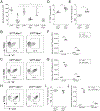Poor-Quality Vβ Recombination Signal Sequences and the DNA Damage Response ATM Kinase Collaborate to Establish TCRβ Gene Repertoire and Allelic Exclusion
- PMID: 35534211
- PMCID: PMC9133172
- DOI: 10.4049/jimmunol.2100489
Poor-Quality Vβ Recombination Signal Sequences and the DNA Damage Response ATM Kinase Collaborate to Establish TCRβ Gene Repertoire and Allelic Exclusion
Abstract
The monoallelic expression (allelic exclusion) of diverse lymphocyte Ag receptor genes enables specific immune responses. Allelic exclusion is achieved by asynchronous initiation of V(D)J recombination between alleles and protein encoded by successful rearrangement on the first allele signaling permanent inhibition of V rearrangement on the other allele. The ATM kinase that guides DNA repair and transiently suppresses V(D)J recombination also helps impose allelic exclusion through undetermined mechanisms. At the TCRβ locus, one Vβ gene segment (V31) rearranges only by inversion, whereas all other Vβ segments rearrange by deletion except for rare cases in which they rearrange through inversion following V31 rearrangement. The poor-quality recombination signal sequences (RSSs) of V31 and V2 help establish TCRβ gene repertoire and allelic exclusion by stochastically limiting initiation of Vβ rearrangements before TCRβ protein-signaled permanent silencing of Vβ recombination. We show in this study in mice that ATM functions with these RSSs and the weak V1 RSS to shape TCRβ gene repertoire by restricting their Vβ segments from initiating recombination and hindering aberrant nonfunctional Vβ recombination products, especially during inversional V31 rearrangements. We find that ATM collaborates with the V1 and V2 RSSs to help enforce allelic exclusion by facilitating competition between alleles for initiation and functional completion of rearrangements of these Vβ segments. Our data demonstrate that the fundamental genetic DNA elements that underlie inefficient Vβ recombination cooperate with ATM-mediated rapid DNA damage responses to help establish diversity and allelic exclusion of TCRβ genes.
Copyright © 2022 by The American Association of Immunologists, Inc.
Conflict of interest statement
Competing Interests
The authors have no competing financial interests to declare.
Figures




Similar articles
-
The Cyclin D3 Protein Enforces Monogenic TCRβ Expression by Mediating TCRβ Protein-Signaled Feedback Inhibition of Vβ Recombination.J Immunol. 2024 Feb 15;212(4):534-540. doi: 10.4049/jimmunol.2300623. J Immunol. 2024. PMID: 38117277 Free PMC article.
-
Poor quality Vβ recombination signal sequences stochastically enforce TCRβ allelic exclusion.J Exp Med. 2020 Sep 7;217(9):e20200412. doi: 10.1084/jem.20200412. J Exp Med. 2020. PMID: 32526772 Free PMC article.
-
Noncore RAG1 regions promote Vβ rearrangements and αβ T cell development by overcoming inherent inefficiency of Vβ recombination signal sequences.J Immunol. 2014 Feb 15;192(4):1609-19. doi: 10.4049/jimmunol.1301599. Epub 2014 Jan 10. J Immunol. 2014. PMID: 24415779 Free PMC article.
-
Regulation of T-cell receptor beta-chain gene assembly by recombination signals: the beyond 12/23 restriction.Immunol Rev. 2004 Aug;200:36-43. doi: 10.1111/j.0105-2896.2004.00156.x. Immunol Rev. 2004. PMID: 15242394 Review.
-
Allelic exclusion at the TCRbeta locus.Curr Opin Immunol. 2002 Apr;14(2):230-4. doi: 10.1016/s0952-7915(02)00326-6. Curr Opin Immunol. 2002. PMID: 11869897 Review.
Cited by
-
Locus folding mechanisms determine modes of antigen receptor gene assembly.J Exp Med. 2024 Feb 5;221(2):e20230985. doi: 10.1084/jem.20230985. Epub 2024 Jan 8. J Exp Med. 2024. PMID: 38189780 Free PMC article.
-
The Cyclin D3 Protein Enforces Monogenic TCRβ Expression by Mediating TCRβ Protein-Signaled Feedback Inhibition of Vβ Recombination.J Immunol. 2024 Feb 15;212(4):534-540. doi: 10.4049/jimmunol.2300623. J Immunol. 2024. PMID: 38117277 Free PMC article.
References
-
- Schatz DG, and Swanson PC. 2011. V(D)J recombination: mechanisms of initiation. Annu Rev Genet 45: 167–202. - PubMed
Publication types
MeSH terms
Substances
Grants and funding
LinkOut - more resources
Full Text Sources
Research Materials
Miscellaneous

